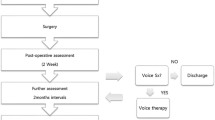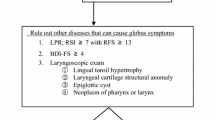Abstract
Globus symptoms are not uncommon after an uncomplicated thyroidectomy. However, their associated factors and etiology have not been investigated. We investigated the etiology and factors related to globus symptoms after thyroidectomy. The medical records of 289 patients who underwent thyroidectomy and completed a voice analysis, psychiatric screening, and voice-related questionnaires before and 1 month after the surgery were reviewed. Patients were excluded if they had globus symptoms before surgery or scored high on the psychiatric questionnaire. The selected patients were divided into two groups according to development of globus symptoms after surgery. Clinicopathological parameters and results of the voice analysis and voice-related questionnaires were compared between the two groups. A total of 157 patients were enrolled, and more than half (80/155, 51 %) showed development of globus symptoms 1 month after thyroidectomy. Female patients [hazard ratio (HR), 2.605; P = 0.010], patients who had central lymph node metastasis (HR, 3.533; P = 0.001), and patients who underwent central neck dissection (HR, 3.652; P = 0.014) had a higher probability of developing globus symptoms. Patients who developed globus symptoms scored higher on the voice-related questionnaire, and had a greater decrease in speaking fundamental frequency (P < 0.001). Globus symptoms developed after 1 month in more than half of patients who underwent thyroidectomy. Female sex and central lymph node metastasis and dissection increased the possibility of developing the symptoms.
Similar content being viewed by others
References
Lombardi CP, Raffaelli M, D’Alatri L, Marchese MR, Rigante M, Paludetti G, Bellantone R (2006) Voice and swallowing changes after thyroidectomy in patients without inferior laryngeal nerve injuries. Surgery 140:1026–1034
Stojadinovic A, Shaha AR, Orlikoff RF, Nissan A, Kornak MF, Singh B, Boyle JO, Shah JP, Brennan MF, Kraus DH (2002) Prospective functional voice assessment in patients undergoing thyroid surgery. Ann Surg 236:823–832
Debruyne F, Ostyn F, Delaere P, Wellens W (1997) Acoustic analysis of the speaking voice after thyroidectomy. J Voice 11:479–482
Sinagra DL, Montesinos MR, Tacchi VA, Moreno JC, Falco JE, Mezzadri NA, Debonis DL, Curutchet HP (2004) Voice changes after thyroidectomy without recurrent laryngeal nerve injury. J Am Coll Surg 199:556–560
Hong KH, Kim YK (1997) Phonatory characteristics of patients undergoing thyroidectomy without laryngeal nerve injury. Otolaryngol Head Neck Surg 117:399–404
Pereira JA, Girvent M, Sancho JJ, Parada C, Sitges-Serra A (2003) Prevalence of long-term upper aerodigestive symptoms after uncomplicated bilateral thyroidectomy. Surgery 133:318–322
Mcivor NP, Flint DJ, Gillibrand J, Morton RP (2000) Thyroid surgery and voice-related outcomes. Aust N Z J Surg 70:179–183
Nam IC, Bae JS, Shim MR, Hwang YS, Kim MS, Sun DI (2012) The importance of preoperative laryngeal examination before thyroidectomy and the usefulness of a voice questionnaire in screening. World J Surg 36:303–309
Cybulska EM (1997) Globus hystericus––a somatic symptom of depression? The role of electroconvulsive therapy and antidepressants. Psychosom Med 59:67–69
Richter P, Werner J, Heerlein A, Kraus A, Sauer H (1998) On the validity of the beck depression inventory. A review. Psychopathology 31:160–168
Poole H, Bramwell R, Murphy P (2009) The utility of the Beck Depression Inventory Fast Screen (BDI-FS) in a pain clinic population. Eur J Pain 13:865–869
Steer RA, Cavalieri TA, Leonard DM, Beck AT (1999) Use of the Beck Depression Inventory for Primary Care to screen for major depression disorders. Gen Hosp Psychiatry 21:106–111
Lombardi CP, Raffaelli M, De Crea C, D’Alatri L, Maccora D, Marchese MR, Paludetti G, Bellantone R (2009) Long-term outcome of functional post-thyroidectomy voice and swallowing symptoms. Surgery 146:1174–1181
Akyildiz S, Ogut F, Akyildiz M, Engin EZ (2008) A multivariate analysis of objective voice changes after thyroidectomy without laryngeal nerve injury. Arch Otolaryngol Head Neck Surg 134:596–602
Henry LR, Solomon NP, Howard R, Gurevich-Uvena J, Horst LB, Coppit G, Orlikoff R, Libutti SK, Shaha AR, Stojadinovic A (2008) The functional impact on voice of sternothyroid muscle division during thyroidectomy. Ann Surg Oncol 15:2027–2033
Harar RP, Kumar S, Saeed MA, Gatland DJ (2004) Management of globus pharyngeus: review of 699 cases. J Laryngol Otol 118:522–527
Katz AD (1986) Extralaryngeal division of the recurrent laryngeal nerve. Report on 400 patients and the 721 nerves measured. Am J Surg 152:407–410
Kreyer R, Pomaroli A (2000) Anastomosis between the external branch of the superior laryngeal nerve and the recurrent laryngeal nerve. Clin Anat 13:79–82
Nemiroff PM, Katz AD (1982) Extralaryngeal divisions of the recurrent laryngeal nerve. Surgical and clinical significance. Am J Surg 144:466–469
Steinberg JL, Khane GJ, Fernandes CM, Nel JP (1986) Anatomy of the recurrent laryngeal nerve: a redescription. J Laryngol Otol 100:919–927
Sañudo JR, Maranillo E, León X, Mirapeix RM, Orús C, Quer M (1999) An anatomical study of anastomoses between the laryngeal nerves. Laryngoscope 109:983–987
Schweizer V, Dörfl J (1997) The anatomy of the inferior laryngeal nerve. Clin Otolaryngol Allied Sci 22:362–369
Brok HA, Copper MP, Stroeve RJ, de Ongerboer Visser BW, Venker-van Haagen AJ, Schouwenburg PF (1999) Evidence for recurrent laryngeal nerve contribution in motor innervation of the human cricopharyngeal muscle. Laryngoscope 109:705–708
Kierner AC, Aigner M, Burian M (1998) The external branch of the superior laryngeal nerve: its topographical anatomy as related to surgery of the neck. Arch Otolaryngol Head Neck Surg 124:301–303
Liebermann-Meffert DM, Walbrun B, Hiebert CA, Siewert JR (1999) Recurrent and superior laryngeal nerves: a new look with implications for the esophageal surgeon. Ann Thorac Surg 67:217–223
Conflict of interest
None.
Ethical statements
This article does not contain any studies with human participants or animals performed by any of the authors.
Informed consent
Informed consent was obtained from all individual participants included in the study.
Author information
Authors and Affiliations
Corresponding author
Rights and permissions
About this article
Cite this article
Nam, IC., Cho, YJ., Bae, JS. et al. Female sex, central lymph node metastasis and dissection are causes of globus symptom after thyroidectomy. Eur Arch Otorhinolaryngol 273, 1607–1613 (2016). https://doi.org/10.1007/s00405-015-3676-8
Received:
Accepted:
Published:
Issue Date:
DOI: https://doi.org/10.1007/s00405-015-3676-8




